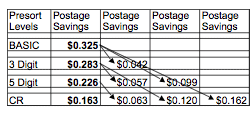Co-Mailing or Co-Palletization: What works best for you?
There's been a lot of talk in the industry about co-mailing and co-palletization as two ways to combat potential postal increases in the coming years. Both are ways to save money on postage; how do they compare? Which is right for you?
Defining The Terms
Co-Mailing
When a publication is co-mailed, it means that the publication's address data file has been added to data files of other publications and presorted together into one mailstream. As you know, the goal of presorting is to create packages of publications with the same level of sortation. The USPS mandates that the package contain a minimum number of copies. Combining publications creates the opportunity to meet that minimum a greater number of times, since the available "pool" of publications is bigger. Therefore, a greater number of copies will qualify for finer presort levels. Within the Periodicals presort there are four (4) presort levels, each with a different postage rate for the copies within the package. The finer the presort, the lower the postage.
Co-Palletization
When a publication is co-palletized, it means that the mailer has placed independently presorted packages of various Periodical Publications on a pallet. These pallets of mail must drop ship to achieve the postage discounts. Postal discounts are based on the number of packages (pieces), not the number of copies within each package.
Comparing the Postage Discounts
Co-Mailing
Since the postage discounts are achieved by having larger counts within a single mailstream, more copies qualify within the lower postage presort levels. This chart  shows the potential per copy savings. Co-mailing when combined with drop shipping can save as much as 14 percent in postage and distribution costs.
shows the potential per copy savings. Co-mailing when combined with drop shipping can save as much as 14 percent in postage and distribution costs.
Co-Palletization
The postage discounts are based on the number of pieces that previously would NOT have been on pallets, and in the number of pieces that move from mailsacks to pallets. The discount is only applied to the pallets that are dropshipped to either an ADC or SCF entry point. Per piece discount for ADC pallet $ 0.007 Per piece discount for SCF pallet $ 0.010 Co-palletizing generally offers a savings of less than one percent, or $0.01 - $0.2 per copy.
So what does this mean?
Clearly there is a greater postage savings opportunity with co-mailing versus co-palletizing. Co-mailing reduces the number of mailsacks used by a publication by an average of 96 percent. That mail is now on pallets, eligible for pallet discounts, and open to much better drop shipping possibilities.
A third option: Fry Affinity Mailing
Fry Affinity Mailing coordinates the binding and mailing of two or more publications or catalogs into one rate saving mailstream. By co-binding and mailing similarly specified products, savings of as much as four to five percent can be achieved.
Fry will work together with publication or catalog candidates and match similarly specified products for co-binding/mailing opportunities provided by Affinity Mailing.
What's a mailer to do?
Given the three options above, or variants therein, a mailer is best advised to:
a) determine in-home delivery dates for mail;
b) determine production and delivery flexibility; and
c) request a mailing quotation and analysis based on a review of their actual mail file and delivery needs.
Generally co-mailing in mail pools that cycle every few days is sufficient for many periodicals while providing the highest level of postal discounts.
As we have for so many customers, we'd be happy to consult with you to match your goals with the appropriate solution. Finding the right tools and the right processes for your needs is how Fry Communications makes the appropriate technology accessible to its customers.
Please contact your Fry Sales Consultant for more information.
